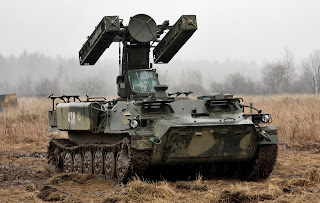The 9K35 Strela-10 is a highly mobile, visually aimed, optical/infrared-guided, low-altitude, short-range surface-to-air missile system. "9K35" is its GRAU designation; its NATO reporting name is SA-13 "Gopher".
The 9K35 is the successor of the 9K31 Strela-1 (SA-9 "Gaskin") and can also use the Strela-1's missiles in place of the 9M37.
The 9K35 is the successor of the 9K31 Strela-1 (SA-9 "Gaskin") and can also use the Strela-1's missiles in place of the 9M37.
Development of the 9K37 Strela-10SV system was initiated July 24, 1969. The decision to begin the development of a new non-all-weather system was taken despite the simultaneous development of an all-weather hybrid gun/missile system 9K22 "Tunguska" mainly as an economical measure. It was also seen as advantageous to have a system capable of fast reaction times and immunity to heavy radio-frequency jamming.
Rather than being mounted on an amphibious but lightly armoured BRDM chassis like the 9K31, the 9K35 is mounted on a more mobile tracked, modified MT-LB, with more room for equipment and missile reloads. Provision for amphibious capability is provided in some variants in the form of polyurethane-filled floats.
The Strela-10SV system and its 9M37 missile were tested in Donguzkom range from 1973 to 1974, but the results were disappointing: the system was found deficient in terms of missile probability of kill, vehicle reliability, among other things. Acceptance to service was thus delayed until May 16, 1976, by which time improvements had been introduced to the system.
Development of the system continued throughout the years through Strela-10M, -10M2 and -10M3 variants introducing among other things improved radio communications and provision for better integration to the Soviet integrated air defence system air picture data. Also improved missiles (9M37M and 9M333) have been developed and by September 2007 the 9K35M3-K Kolchan variant, mounted on a BTR-60 wheeled chassis, was displayed for the first time at the Moscow Air Show MAKS 2007. More details
Rather than being mounted on an amphibious but lightly armoured BRDM chassis like the 9K31, the 9K35 is mounted on a more mobile tracked, modified MT-LB, with more room for equipment and missile reloads. Provision for amphibious capability is provided in some variants in the form of polyurethane-filled floats.
The Strela-10SV system and its 9M37 missile were tested in Donguzkom range from 1973 to 1974, but the results were disappointing: the system was found deficient in terms of missile probability of kill, vehicle reliability, among other things. Acceptance to service was thus delayed until May 16, 1976, by which time improvements had been introduced to the system.
Development of the system continued throughout the years through Strela-10M, -10M2 and -10M3 variants introducing among other things improved radio communications and provision for better integration to the Soviet integrated air defence system air picture data. Also improved missiles (9M37M and 9M333) have been developed and by September 2007 the 9K35M3-K Kolchan variant, mounted on a BTR-60 wheeled chassis, was displayed for the first time at the Moscow Air Show MAKS 2007. More details

